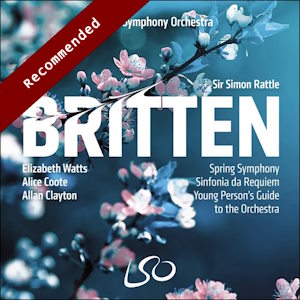
Benjamin Britten (1913-1976)
Sinfonia da Requiem, op. 20 (1940)
Spring Symphony, op. 44 (1948-9)
The Young Person’s Guide to the Orchestra, op. 34 (1945)
Elizabeth Watts (soprano), Alice Coote (mezzo-soprano), Allan Clayton (tenor)
Tiffin Boys’ Choir, Tiffin Children’s Chorus, The Tiffin Girls’ School Choir, London Symphony Chorus
London Symphony Orchestra/Sir Simon Rattle
rec. 2018-21, Barbican Hall, London
LSO Live LSO0830 [79]
The decade that encloses the works on this disc was when Britten arguably composed his very finest works. In the same period he also wrote the Serenade, the Hymn to St. Cecilia and, most notably, his first true opera, Peter Grimes; all of these show his inspiration at white-hot temperature. From an early age, Britten had demonstrated a remarkable facility, and by now he was a master of all the media for which he wrote, be it choir, solo voice or orchestra – or indeed any combination of those.
The Sinfonia da Requiem is a prime example of all that; it is, to be honest, a shatteringly powerful work. It was commissioned in 1939 by the Japanese government, who wanted to include some premieres of Western music in their celebrations for the alleged 2600th anniversary of the Mikado dynasty (though that dating has since been strongly disputed). But the commission was cancelled, ostensibly because of the references to the Latin Mass, from which the titles of the three movements are drawn. However, the real reason was probably Britten’s well-known pacifist views. The premiere would have been towards the end of 1940; Japan made its spectacular entrance into the hostilities of WW2 in December 1941, attacking the American fleet at its Hawaiian base of Pearl Harbour. Hence the premiere took place instead in New York in 1941, with Barbirolli as conductor.
Rattle’s reading of this extremely powerful score, and the LSO’s playing of it, is, as you would expect, of a very high quality, with all three movements characterised vividly. No Britten enthusiast should be disappointed, for the textures are balanced to perfection, while all the colours of the orchestration – it’s hard to believe that this is Britten’s first large-sale orchestral work – shine out brilliantly.
There are many fine recordings of the piece, and I have been tremendously impressed with that by Mirga Gražinytė-Tyla with the CBSO, made in 2019. Where she has a fine edge on Rattle is in the growing sense of catastrophe in the first movement, leading to a truly overwhelming return of the opening crashes, timpani now augmented by bass drum. Nevertheless, Rattle’s response to the work as a whole is entirely convincing, and here as elsewhere he draws wonderful playing from his orchestra.
The Spring Symphony of 1949 is a very different kettle of fish. Here again, though, Britten shows his mastery, for he makes us wait for the true arrival of the loveliest of seasons. The opening is cold and dark, expressing the visceral longing for warmth and light that we feel – very much as I write! – as the winter refuses to release its grip. But by the time we reach the final movement’s Beaumont and Fletcher setting, Summer is clearly almost with us.
Simon Rattle has brought together an outstanding ensemble to help deliver this. All three soloists make very fine contributions, notably tenor Allan Clayton’s mesmerising mezzo-voce in ‘Waters above’, then the same singer joined by the soprano Elizabeth Watts in the flirtatious ‘Fair and Fair’. But for me the highlight of the whole symphony is Alice Coote’s unforgettable singing of the great Auden setting ‘Out on the lawn I lie in bed’, with its uneasy woodwind and ghostly wordless chorus. It’s impossible to imagine a finer interpreter of this, one of Britten’s supreme achievements. The choral forces rise to the multiple challenges well, and if it’s hard to make out many of the words in the final movement – well, that is certainly at least as much Britten’s fault as the singers! Not that it prevents everyone from having tremendous fun with this riotous conclusion.
And this generously filled disc ends with another Britten favourite, the Young Person’s Guide to the Orchestra. It’s heard mercifully without the spoken commentary, which might be part of the original concept, but does spoil the continuity of this spectacularly enjoyable masterpiece. There are of course dozens of recordings, audio and video, but the one every recording must be compared with is Britten’s own, with the ‘same’ orchestra. Although this dates from the 1960s, it represents Decca of that day at its very best, with a near-perfect balance between the projection of all those solos and the imposing sound needed for the big tuttis. Rattle and the LSO give it the full works, and all the individual and section passages are top-class. The very fast tempo for the final fugue is hair-raising, and a little lack of clarity here and there is the result – to be fair, the speed does slacken slightly when the strings come in!
This is a very fine recording, though, with an unmistakable ‘feel’ for Britten’s style. And speaking personally, it is now my preferred recording of the Spring Symphony, even though Britten’s own and Hickox’s very fine one are still more than worth their place on the shelves. Sir Simon’s time at the helm of this great orchestra was all too brief; recordings like this are reminders of how much we already miss him.
Gwyn Parry-Jones
Previous review: John Quinn (May 2024)
Buying this recording via a link below generates revenue for MWI, which helps the site remain free



















